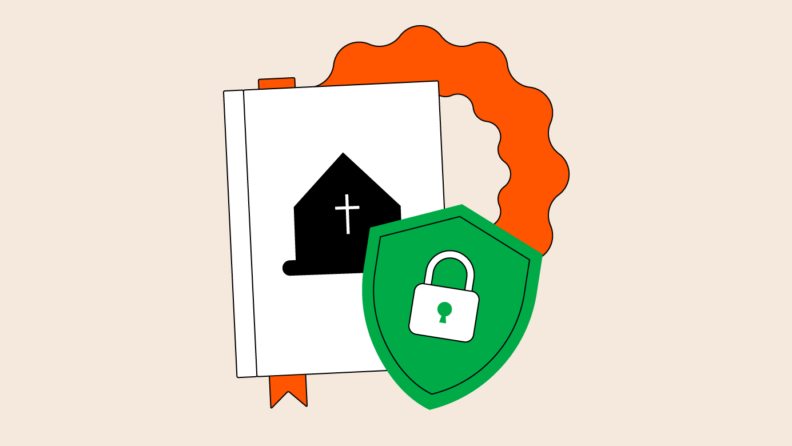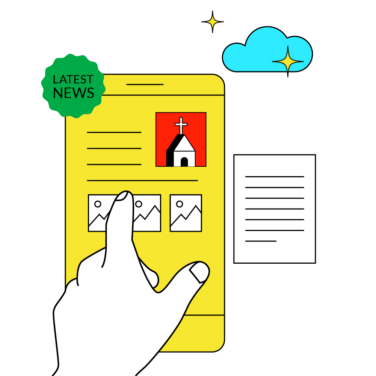Putting together a church security manual can seem like either 1) a quick and easy task to check off in an afternoon or 2) a daunting task that will take months to complete. Thankfully, it doesn’t have to be either of those things.
I have helped my own churches come up with church security plans and church security manuals for a variety of situations that were genuine concerns for our congregation.
The good news is that these experiences better equipped me to serve others well in future crisis situations with the help of a solid church security manual. Throughout this article, I am going to define a church security manual, why it’s important, give you some great examples, and walk through how to create your own church security manual.
What Is A Church Security Manual?
A church security manual is a tool for clarifying procedures for the safety and security of church members, staff, and guests. If church safety is at all important to your congregation, then your church needs to establish a church security manual for the betterment of your community.
If you have a security team or a security ministry, then this will be the living document utilized by all members of the church, as well as church leadership, to keep your building, your congregation, and your community as safe as possible.
Learn more about church security checklists, a related document.
What Should A Church Security Manual Cover?
Based on a Lifeway Research study done in 2019 and reported in 2020, 38% of churches don’t have any sort of plan for an active shooter situation. In our day and age, this is simply unacceptable. Below are a few types of events or situations every church security manual should include:
- Medical emergencies
- Background checks
- Community shootings
- Active shooter situations
- Emergency response protocols (natural disasters like fires, floods, etc.)
- Lockdown procedures
- Parking lot accidents or injuries
- Vandalism
- Data security issues
- Cooperation with law enforcement officer procedures
- First aid procedures
- Roles and assignments of the church security team members
While there are a wide range of church security policies that might apply to your specific location and congregation, these are the items that absolutely must be in your church security manual. This church security manual will be critical when any kind of emergency crops up, but why else might it be important?
Why Is A Church Security Manual Important?
A church security manual lists all the procedures put in place to keep your community safe. This positions your church as a pillar of accountability and stability for your larger community. When your church leaders see how your church can be a place of safety and security in your community, then they can begin to see the value in the time, effort, and resources invested.
If there is a natural disaster in your community and your church security plan has outlined an emergency response for that disaster, then people can see the church as a helpful resource. The same is true if local law enforcement recognize your church as a safe shelter for those going through a variety of emergency or crisis situations.
A detailed and clear church security manual can ensure your organization, your congregation, your church staff as a pillar of the community for when bad things happen, as they inevitably will. In those moments, you are able to share the love of God through the grace and mercy of Jesus Christ to those in some of the greatest need in their life.
Church Security Manual Example
Creating a church security manual from scratch can be intimidating. If you have already created a church security team or drafted a church security plan, then you are already halfway there. Having a staff member or the security director of the security team finish the full-fledged church security manual should be simple.
Below are some of the sections you need to include in your church security manual alongside some templates and examples to help shape your church security manual. I recommend detailing everything from how cell phones are used in a church emergency to specific equipment for each emergency situation. Add or subtract as you need for your congregation!
Purpose statement
Your church security manual should include the purpose behind having a church security team or security ministry as well as how risk assessments and safety audits will be performed to ensure security measures as part of your church facility management strategy will be consistently evaluated and improved.
Church security team roles and goals
The church security manual should clearly identify the make up and overall goals of the church security team, who is in charge and when, and the roles of security team members alongside emergency contact info. A great example is this template from My Church Security for roles for security teams.
List all church security plan equipment
A clearly defined list of all safety equipment being used, where it is located in the building, and who has access to it should be near the top of your church security manual. This way, whether it is an EMT or a local law enforcement officer, equipment can be easily utilized in church emergency situations.
Training and continuous improvement plan
A solid church security manual will include all the ways individuals can and will be trained for the purpose of church safety, from greeters to ushers to church staff. Clinton First United Methodist has a great church security manual template that covers training in detail.
How To Create A Church Security Manual In 8 Steps
Now that you know what needs to be included in your church security manual, it’s time to figure out how to bring everything together. The process for this is similar to any other sort of safety plan, risk assessment plan, or crisis management document. Below, I am going to tackle a flexible order to consider as you flesh out your church security manual.
1. Address congregational concerns
Start by talking to your church members and address their concerns first. These will often be the most visible tasks to tackle, but your members might surprise you with some insights your safety team hadn’t considered.
2. Address your church security team’s concerns
You have likely already done this step, but starting with the people most directly involved in the process will go a long way to making sure the team takes ownership of the process. This will also give you an idea of who is interested in working on what as you move forward with your church security manual.
3. Research any legal documentation or other requirements
Depending on your location there may be state or local laws you need to follow as you address security issues at your church. Likely, this will also be the point where you will need to bring in other local organizations to ensure your church is up to code on certain requirements. Include everything you can in your church security manual for future teams to be on the same page.
4. Establish organizational structures
Establish and clearly outline an organizational structure for your security team. This includes designating a security director who will lead the church security team but could also list roles such as “CPR Certified Individuals” so you have a running list at your church of who is qualified to provide first aid until EMTs or other professionals arrive.
5. Outline procedures and purpose
This is where the rubber meets the road because it is time to outline every procedure you have discussed for various emergencies as well as all of the purpose statements. This is when your living document begins to take shape and become more official.
6. Update and mark all security equipment
From fire extinguisher locations to knowing where all exit signs and lights are located, everything your church will be using in emergency situations needs to be clearly identified, marked, and recorded in your church security manual.
7. Map out training processes
With everything else out of the way, it’s time to map out (and create space for) all future training, seminars, conferences, etc. to keep educating yourself and your security team. This is a critical part of your church security manual because it will outline how your church plans to keep improving their safety and security throughout the years to come.
8. Schedule surveys
Include in your church security manual when you plan to do congregational and community surveys, how those surveys will be handled, and when you will annually review your church security manual for updates. Including this in your church security manual will create a system of checks and balances to make sure your church is consistently on top of safety and security concerns.
Interested In Learning More About Church Security?
If this is your first time diving into the beautiful mess of church security, then make sure to subscribe to The Lead Pastor newsletter to get regular updates via our newsletter on all things crisis management plans, organizational structures, or even finance management!



